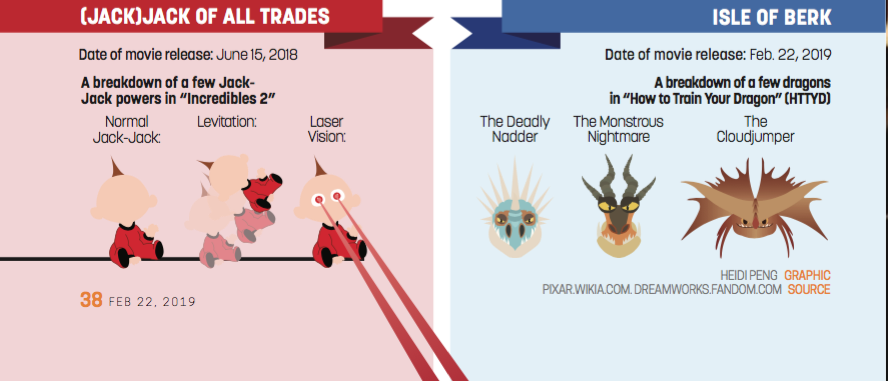The “Incredibles,” “F inding Nemo,” “How To Train Your Dragon”—all were movies that wedged their way into the hearts of children and adults alike, despite having one other commonality that would appear to deter popularity: they all left a large gap of time in between the original movie and the sequels. In the case of “The Incredibles” and “Finding Nemo,” the window of time exceeded 10 years. Filmakers hope tonight’s release of “How To Train Your Dragons 3,” which is nine years removed from the original film and five from its sequel, will capture the same box office magic. If those other films are any indication, prospects look good. For both movies, the box office totals of the sequels still rose far above the originals. According to Variety, “The Incredibles” made $70.5 million during its opening weekend while “The Incredibles 2” brought in $180 million in the same time frame.
inding Nemo,” “How To Train Your Dragon”—all were movies that wedged their way into the hearts of children and adults alike, despite having one other commonality that would appear to deter popularity: they all left a large gap of time in between the original movie and the sequels. In the case of “The Incredibles” and “Finding Nemo,” the window of time exceeded 10 years. Filmakers hope tonight’s release of “How To Train Your Dragons 3,” which is nine years removed from the original film and five from its sequel, will capture the same box office magic. If those other films are any indication, prospects look good. For both movies, the box office totals of the sequels still rose far above the originals. According to Variety, “The Incredibles” made $70.5 million during its opening weekend while “The Incredibles 2” brought in $180 million in the same time frame.
Graham Haines, IB film student and senior, said he believes this trend occurs among popular childhood films.
“I think nostalgia is exactly why movies like ‘The Incredibles’ or ‘Star Wars’ are able to keep viewership up. You will always have the old fans who will come back and watch it, but you also get the excitement from the younger generation,” he said.
Still, while movie franchises can find security in the loyalty of their fanbase because of the nostalgia associated with their films, this time gap can also hurt the franchise.
IB psychology teacher Peter O’Hara explained this idea using aspects of human behaviorism.
“In behaviorism, the shorter the time in between reinforcements (like a new movie), the better. You’re more than likely to go to a movie when there is less time in between,” he said. “I think the challenge, in the future, is the younger generation who is used to having quicker turn-around on just about everything.”
According to Mallory Cole, IB film student and senior, the time gap can lose viewership because the younger generation, who missed the time period for the first film, has no connection to the new one.

“I think people like to identify with their own films and not the films their elders identified with,” she said. “I thin
k sequels to popular films can excite the older generation who was there when the first movie came out, but I don’t think the younger generation will be as excited about the sequels because of the time gap.”
Despite all these challenges that could possibly hurt franchises that make sequels with a large window of time in between, according to Haines, what makes these popular childhood movies stand out and defy the assumptions of moviegoers are fond memories attached to the stories.
He said, “I think a lot of classic movies are tied to a generation of people and as they get older, their movie tastes change, but with something like ‘The Incredibles,’ it’s such a classic that people from all generations will continue to watch it.”
































![What happened to theater etiquette? [opinion]](https://hilite.org/wp-content/uploads/2025/04/Entertainment-Perspective-Cover-1200x471.jpg)














































![Review: “The Immortal Soul Salvage Yard:” A criminally underrated poetry collection [MUSE]](https://hilite.org/wp-content/uploads/2025/03/71cju6TvqmL._AC_UF10001000_QL80_.jpg)
![Review: "Dog Man" is Unapologetically Chaotic [MUSE]](https://hilite.org/wp-content/uploads/2025/03/dogman-1200x700.jpg)
![Review: "Ne Zha 2": The WeChat family reunion I didn’t know I needed [MUSE]](https://hilite.org/wp-content/uploads/2025/03/unnamed-4.png)
![Review in Print: Maripaz Villar brings a delightfully unique style to the world of WEBTOON [MUSE]](https://hilite.org/wp-content/uploads/2023/12/maripazcover-1200x960.jpg)
![Review: “The Sword of Kaigen” is a masterpiece [MUSE]](https://hilite.org/wp-content/uploads/2023/11/Screenshot-2023-11-26-201051.png)
![Review: Gateron Oil Kings, great linear switches, okay price [MUSE]](https://hilite.org/wp-content/uploads/2023/11/Screenshot-2023-11-26-200553.png)
![Review: “A Haunting in Venice” is a significant improvement from other Agatha Christie adaptations [MUSE]](https://hilite.org/wp-content/uploads/2023/11/e7ee2938a6d422669771bce6d8088521.jpg)
![Review: A Thanksgiving story from elementary school, still just as interesting [MUSE]](https://hilite.org/wp-content/uploads/2023/11/Screenshot-2023-11-26-195514-987x1200.png)
![Review: "When I Fly Towards You", cute, uplifting youth drama [MUSE]](https://hilite.org/wp-content/uploads/2023/09/When-I-Fly-Towards-You-Chinese-drama.png)
![Postcards from Muse: Hawaii Travel Diary [MUSE]](https://hilite.org/wp-content/uploads/2023/09/My-project-1-1200x1200.jpg)
![Review: "Ladybug & Cat Noir: The Movie," departure from original show [MUSE]](https://hilite.org/wp-content/uploads/2023/09/Ladybug__Cat_Noir_-_The_Movie_poster.jpg)
![Review in Print: "Hidden Love" is the cute, uplifting drama everyone needs [MUSE]](https://hilite.org/wp-content/uploads/2023/09/hiddenlovecover-e1693597208225-1030x1200.png)
![Review in Print: "Heartstopper" is the heartwarming queer romance we all need [MUSE]](https://hilite.org/wp-content/uploads/2023/08/museheartstoppercover-1200x654.png)


